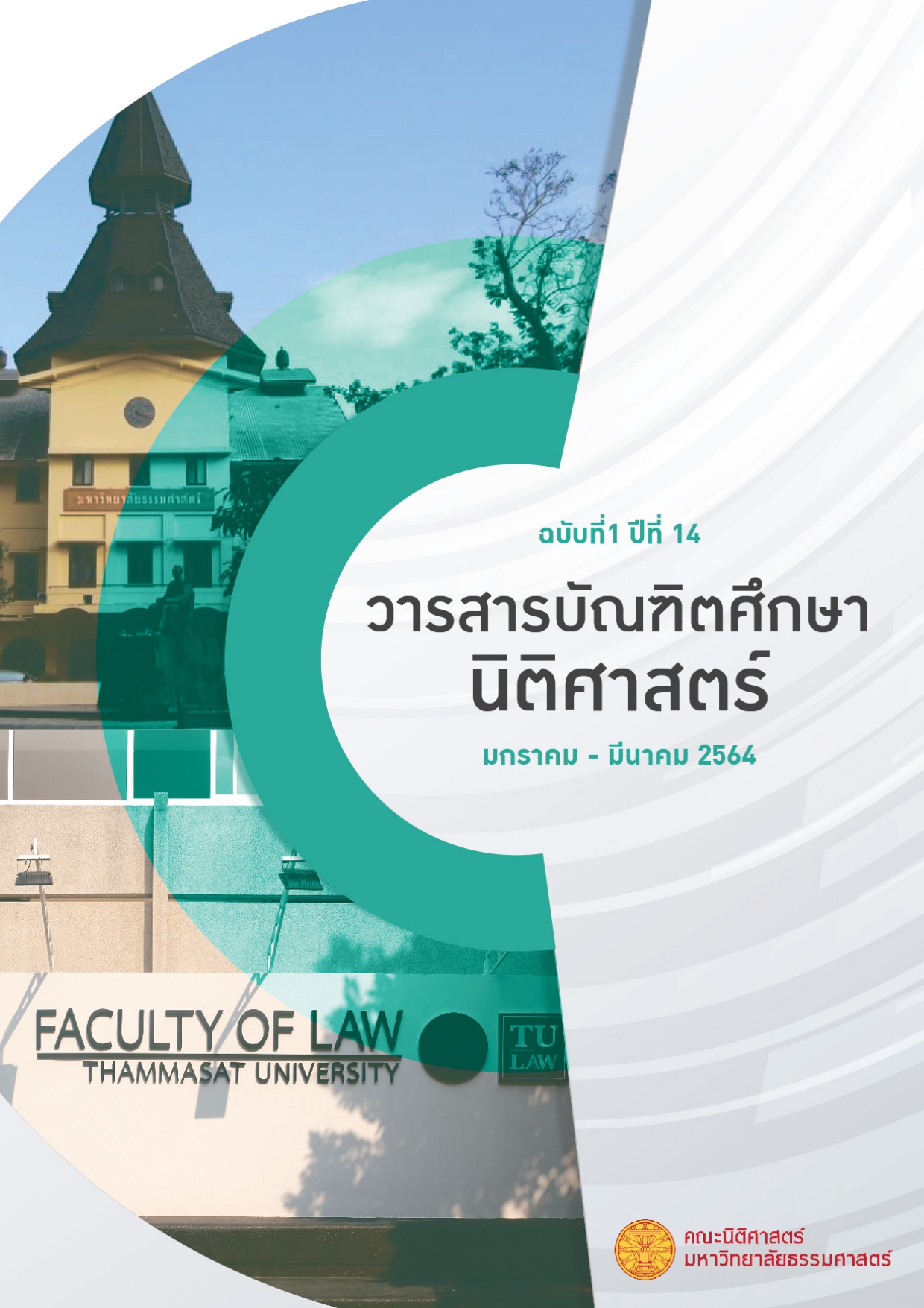LEGAL MEASURES RELATED TO ENVIRONMENTAL IMPACT ASSESSMENT TO PREVENT THE CUMULATIVE ENVIRONMENTAL IMPACT
Main Article Content
Abstract
Environmental Impact Assessment is a tool to obtain environmental information for making environmental decisions. At present, Thailand has adopted the environmental impact assessment concept in the law as provided in Article 58, the Constitution of the Kingdom of Thailand, B.E. 2560 and Promotion and Conservation of National Environmental Quality Act, B.E. 2535 and its amendments. However, even though Thailand requires an environmental impact assessment, it was found that in the project areas or activities conducting the environmental impact assessment. According to the law, there was still an environmental impact as a result of the cumulative environmental impact. Therefore, it is necessary to establish legal measures to resolve such problems. The author has studied the Promotion and Conservation of National Environmental Quality Act B.E. 2535 and its amendments regarding the environmental impact assessment. And studying the Canadian law and European Union (EU) regulation to apply and solve problems.
The study found that the Promotion and Conservation of the National Environmental Quality Act B.E. 2535 and its amendments still had several legal problems, including the definition and meaning of environmental impact assessment, the project or activity problems that do not require an environmental impact assessment and legal issues do not cover considering the cumulative environmental impact. The author has four suggestions: First, amendment to the law on definitions “Environmental Impact Assessment” should cover accumulated environmental impacts from projects or activities that are similar or likely to impact the environment in the past, present and future, including adding a definition. Second, revise measures to control projects or activities and corporate them into the environmental impact assessment process. Third, amendment to relevant laws include consideration of cumulative environmental impact such as controlling for strategic impact assessment in addition to a project level environmental impact assessment, defining the elements of the environmental impact statement to cover the cumulative environmental impact and allow the authority to take the environmental impact statement of other projects can be considered. Finally, the use of other tools and methods in accordance with sustainable development approaches to support decision making.
Article Details
บทความหรือข้อความคิดเห็นใด ๆ ที่ปรากฏในวารสารบัณฑิตศึกษานิติศาสตร์เป็นวรรณกรรมของผู้เขียนโดยเฉพาะคณะนิติศาสตร์ มหาวิทยาลัยธรรมศาสตร์ และบรรณาธิการไม่จำเป็นต้องเห็นด้วย
References
1. ฉัตรไชย รัตนไชย, การประเมินผลกระทบสิ่งแวดล้อม, พิมพ์ครั้งที่ 2, กรุงเทพฯ: โรงพิมพ์แห่งจุฬาลงกรณ์มหาวิทยาลัย, 2553
2. สฤณี อาชวานันทกุล, ภัทราพร แย้มลออ, คู่มือการประเมินผลลัพธ์ทางสังคมและผลตอบแทนทางสังคมจากการลงทุน, พิมพ์ครั้งที่ 1, กรุงเทพฯ: สำนักงานกองทุนสนับสนุนการวิจัย (สกว.), 2560
3. สำนักงานนโยบายและแผนทรัพยากรธรรมชาติและสิ่งแวดล้อม, แนวทางการมีส่วนร่วมของประชาชนและการประเมินผลกระทบสิ่งแวดล้อมทางสังคมในกระบวนการวิเคราะห์ผลกระทบสิ่งแวดล้อม, พิมพ์ครั้งที่ 4, กรุงเทพฯ :โรงพิมพ์ยูโรการพิมพ์ จำกัด, 2551
4. สำนักงานนโยบายและแผนทรัพยากรธรรมชาติและสิ่งแวดล้อม, การประเมินสิ่งแวดล้อมระดับยุทธศาสตร์, พิมพ์ครั้งที่ 2, กรุงเทพฯ : หจก. บี.วี.ออฟเซ็ต, 2554
5. อำนาจ วงศ์บัณฑิต, กฎหมายสิ่งแวดล้อม, พิมพ์ครั้งที่ 4, กรุงเทพฯ: สำนักพิมพ์วิญญูชน, 2562
วิทยานิพนธ์
1. ปวันรัตน์ คงวาณิช, “มาตรการทางกฎหมายเกี่ยวกับการกลั่นกรองโครงการหรือกิจการที่ต้องจัดทำรายงานวิเคราะห์ผลกระทบสิ่งแวดล้อมในประเทศไทยเปรียบเทียบต่างประเทศ” (วิทยานิพนธ์ นิติศาสตร์มหาบัณฑิต) มหาวิทยาลัยธรรมศาสตร์, 2558
2. สุทธิดา ฝากคำ, “ระบบการวิเคราะห์ผลกระทบด้านสิ่งแวดล้อมและสุขภาพในประเทศไทย” (วิชาการค้นคว้าอิสระ วิทยาศาสตร์มหาบัณฑิต) สถาบันบัณฑิตพัฒนบริหารศาสตร์, 2556
เอกสารอิเล็กทรอนิกส์
1. คณะกรรมาธิการลุ่มแม่น้ำโขง “ชุดหลักสูฅรเพึ่อฝึกอบรม ด้านสิ่งแวดล้อม การประเมินผลกระทบสะสม”, http://archive.iwlearn.net/mrcmekong.org/envir_training_kit/Thai_Index.htm, วันที่ 5 เมษายน 2562
2. มหาวิทยาลัยสุโขทัยธรรมาธิราช, เรวดี จรุงรัตนาพงศ์, “การวิเคราะห์ต้นทุนและประโยชน์ของโครงการ”, https://www.stou.ac.th/read_write/file/CBA_STOU-04042015.pdf, วันที่ 26 เมษายน 2562
3. ศาลปกครองระยอง “คดีศาลปกครองระยองคดีหมายเลขแดงที่32/2552”,https://enlawfoundation.org/newweb/wpcontent/uploads/mabtapud_pollutioncontroladmincourt.pdf, 3 เมษายน 2562
4. สำนักงานสภาพัฒนาการเศรษฐกิจและสังคมแห่งชาติของประเทศไทย, “แนวทาง (Guideline) การประเมินสิ่งแวดล้อมระดับยุทธศาสตร์”,https://www.nesdc.go.th/ewt_w3c/ewt_dl_link.php?nid=8372, วันที่ 3 เมษายน 2562
เอกสารอื่น ๆ
1. รัฐธรรมนูญแห่งราชอาณาจักรไทย พ.ศ. 2560. ราชกิจจานุเบกษา. เล่ม 134. ตอนที่ 40 ก. น. 1. (6 เมษายน 2560).
2. พระราชบัญญัติส่งเสริมและรักษาคุณภาพสิ่งแวดล้อมแห่งชาติ พ.ศ. 2535. ราชกิจจานุเบกษา. เล่ม 109.ตอนที่ 37.น. 1. (4 เมษายน 2535).
3. พระราชบัญญัติส่งเสริมและรักษาคุณภาพสิ่งแวดล้อมแห่งชาติ (ฉบับที่ 2) พ.ศ. 2561. ราชกิจจานุเบกษา. เล่ม 135. ตอนที่27 ก. น.29. (19 เมษายน 2561).
4. ประกาศกรมเชื้อเพลิงธรรมชาติ เรื่อง หลักเกณฑ์ วิธีการ และเงื่อนไข สำหรับการจัดทำรายงานและแผนตามกระบวนการบริหารจัดการสิ่งแวดล้อมจากการรื้อถอน. ราชกิจจานุเบกษา. เล่ม 135. ตอนพิเศษ148 ง, น.13. (26 มิถุนายน 2561).
5. ประกาศคณะกรรมการสิ่งแวดล้อมแห่งชาติ เรื่อง หลักเกณฑ์และวิธีการในการแต่งตั้งคณะกรรมการผู้ชำนาญการ. ราชกิจจานุเบกษา. เล่ม 135. ตอนพิเศษ 206 ง. น. 24. (27 สิงหาคม 2561).
6. ประกาศกระทรวงทรัพยากรธรรมชาติและสิ่งแวดล้อม, เรื่อง กำหนดโครงการ กิจการ หรือการดำเนินการซึ่งต้องจัดทำรายงานการประเมินผลกระทบสิ่งแวดล้อม และหลักเกณฑ์ วิธีการ และเงื่อนไขในการจัดทำรายงานการประเมินผลกระทบสิ่งแวดล้อม. ราชกิจจานุเบกษา. เล่ม 136.
ตอนพิเศษ 3 ง. น.1. (4 มกราคม 2562)
7. ประกาศกระทรวงทรัพยากรธรรมชาติและสิ่งแวดล้อม, เรื่อง กำหนดโครงการ กิจการ หรือการดำเนินการที่อาจมีผลกระทบต่อทรัพยากรธรรมชาติ คุณภาพสิ่งแวดล้อม สุขภาพ อนามัย คุณภาพชีวิตของประชาชนในชุมชนอย่างรุนแรง ซึ่งต้องจัดทำรายงานการประเมินผลกระทบสิ่งแวดล้อมและหลักเกณฑ์ วิธีการ และเงื่อนไขในการจัดทำรายงานการประเมินผลกระทบสิ่งแวดล้อม. ราชกิจจานุเบกษา. เล่ม 136. ตอนพิเศษ 3 ง. น.12. (4 มกราคม 2562).
BOOKS
1. Business and Biodiversity Offsets Programme (BBOP), Glossary, 2nd edition (Washington, D.C., 2012)
2. Hegmann, G., et al., Cumulative Effects Assessment Practitioners Guide. Prepared for the Canadian Environmental Assessment Agency, (Hull, Quebec, 1999),
3. John Glasson, Riki Therivel and Andrew Chadwick, Introduction to environmental impact assessment, Edition 3, (Routledge: 2005)
4. Larry Canter and Sam Atkinson, Cumulative Effects Assessment, (New York: U.S. Environmental Protection Agency, 1999)
5. Mandy Elliot and Ian Thomas, Environmental impact assessment in Australia: theory and practice, 5th edition (Federation Press, 2009)
6. Owen Harrop, Ashley Nixon, Environmental Assessment in Practice, 1st Edition (Routledge: 1999)
7. Peter Wathern, Environmental Impact Assessment: Theory and practice, (Routledge: 2004)
8. Ronnie Harding, Cyrolyn M Hendriks & Mehreen Faruqi, Environmental decision-making: exploring complexibility and context (Federation Press, 2009)
9 The World Bank group, Getting to Green - A Sourcebook of Pollution Management Policy Tools for Growth and Competitiveness, (Washington DC: 2012)
ELECTRONIC MEDIA
1. CEQ NEPA Regulations, “40 CFR 1508.7”, https://www.law.cornell.edu/cfr/text/40/1508.7, April 3, 2019
2. European Commission, “Environmental Impact Assessment”, https://ec.europa.eu/environment/eia/eia-legalcontext.htm, April 20, 2019
3. International Association for Impact Assessment (IAIA), “Cumulative Effects Assessment and Management”, https://www.iaia.org/wiki-details.php?ID=9, April 3, 2019
4. Official website of the European Union, “Court of Justice of the European Union (CJEU)”, https://europa.eu/european-union/about-eu/institutions-bodies/court-justice_en, April 20, 2019
Another document
1. Canadian Environmental Assessment Act 2012 (CEAA 2012)
2. EIA Directive (2014/52/EU)
3. The National Environmental Policy Act of 1969 (NEPA 1969)

